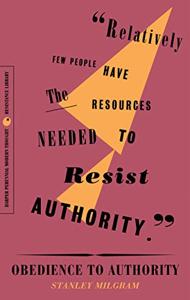
Want to learn the ideas in Obedience to Authority better than ever? Read the world’s #1 book summary of Obedience to Authority by Stanley Milgram here.
Read a brief 1-Page Summary or watch video summaries curated by our expert team. Note: this book guide is not affiliated with or endorsed by the publisher or author, and we always encourage you to purchase and read the full book.
Video Summaries of Obedience to Authority
We’ve scoured the Internet for the very best videos on Obedience to Authority, from high-quality videos summaries to interviews or commentary by Stanley Milgram.
1-Page Summary of Obedience to Authority
Overview
When we hear the words “obey” and “order,” it’s easy to think of a totalitarian dictatorship or religious sect. However, obedience is an integral part of any hierarchical structure in society. We obey laws, managers at work and parents, for example. Without obedience society might not function properly at all. So what’s the problem with obeying?
There is a darker side to obedience. Throughout history, it has enabled genocides and war crimes by making ordinary people into murderers and torturers. So what are the mechanisms that make us do these things?
In this passage, we will follow Stanley Milgram as he tries to figure out why people are so easily influenced by authority. We will explore the classic Milgram Experiment and find that the better angels of our nature can be dissuaded from doing good things.
In this passage, the author explains how being close to someone can make them more resistant to authority. The agentic state is a feeling of empowerment that makes people feel like they’re in control and able to obey orders. A lab coat gives doctors an image of authority and causes patients to listen closely when they speak.
Big Idea #1: Obeying authority has led to some of the most heinous crimes in human history.
When you were young, your teachers and parents told you to do certain things. You probably did them because they were in charge. It’s not a bad thing to obey authority figures, but sometimes obeying can be harmful.
Obedience is the root of many atrocities committed in human history. The Holocaust, for example, was carried out by people who were simply following orders from their government. While some tried to resist these mass murders, most Germans didn’t fight against Hitler’s regime. As a result, millions of Jews died at concentration camps that piled up with corpses as high as small hills. In Vietnam War too, American soldiers killed innocent civilians and raped women and children while claiming to be innocent because they were just following orders.
Most people would say that they’d never harm another human being. However, after examining some historical atrocities, most of us would claim that we’d never act on the command to kill or harm someone. It’s easy for us to put our trust in our own morals and ethical standards as well as humanity itself to save us from turning into cruel beasts who will do whatever they’re told. Without a scientific reference point, it’s hard to know just how cruel we might become under pressure from authority figures. That is where Stanley Milgram comes in with his experiments on obedience.
Big Idea #2: Stanley Milgram sought reasons for human obedience in a series of experiments.
The author was shocked by the genocide and horrors of the Nazi regime, so he conducted a series of experiments to figure out how people could do such things.
His experiment was simple, but it worked. He found a way to simulate the pressures that caused people to hurt others.
The participants were told that the experiment was about improving learning abilities by punishing mistakes. Three people were involved: an approachable man dressed in a lab coat, who acted as the “experimenter”; a volunteer actor; and a naive subject, who had volunteered for the experiment.
The teacher and the learner were aware of what was going on, while the subject who was being tested didn’t know anything about it. To get a broad sample, thousands of people participated in the experiment. The draw to determine roles was rigged so that each participant would always be assigned as the teacher.
During an experiment, the learner and teacher were separated by a partition. The teacher was instructed to help the learner learn word pairs by administering electric shocks each time he got a pair wrong. The shocks started at tolerable 15 volts and went up to mortally dangerous 450 volts, with pain level clearly displayed on the shock generator. Even as the learner started screaming in agony and begging to be released, the experimenter advised her to continue with the shocks.





